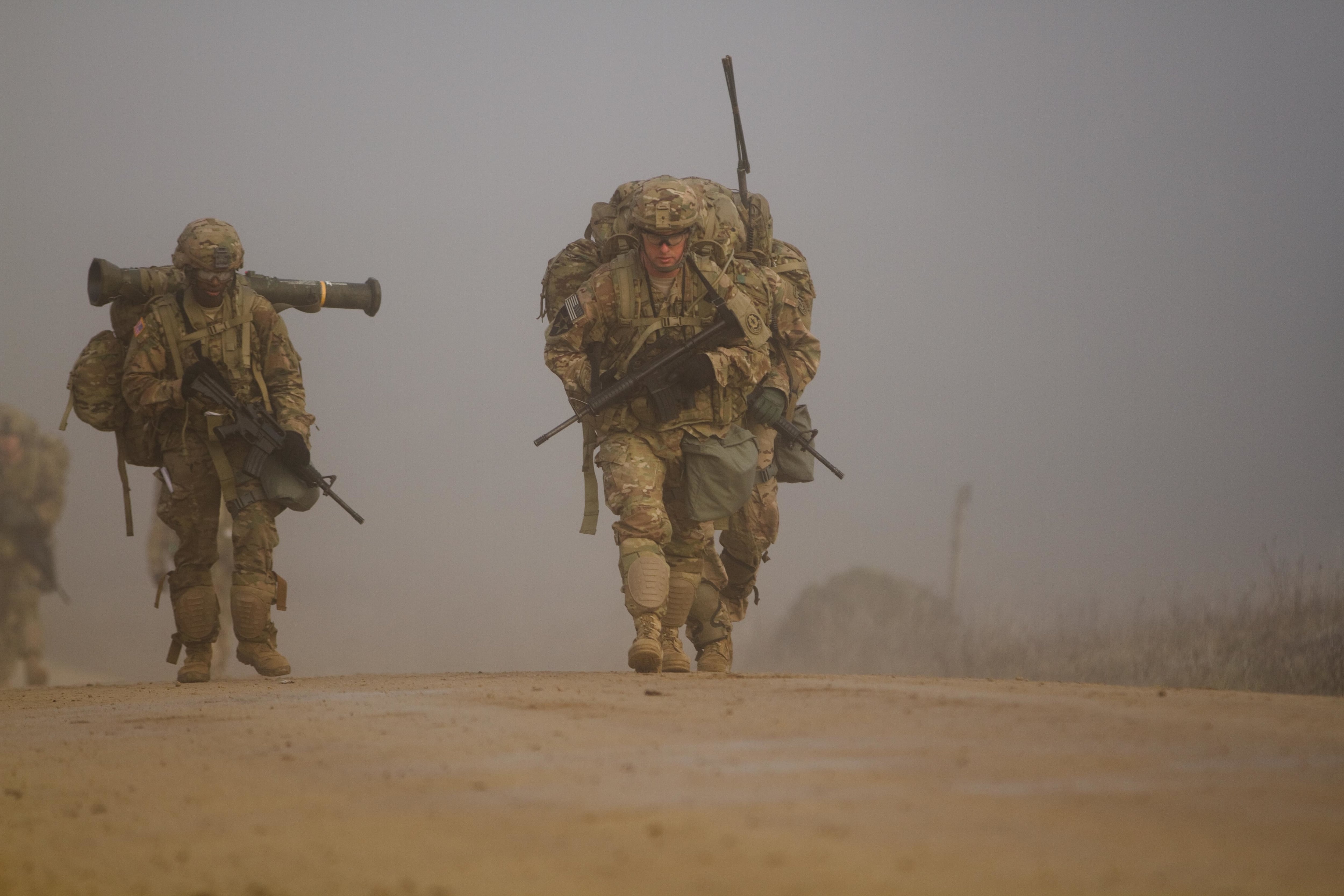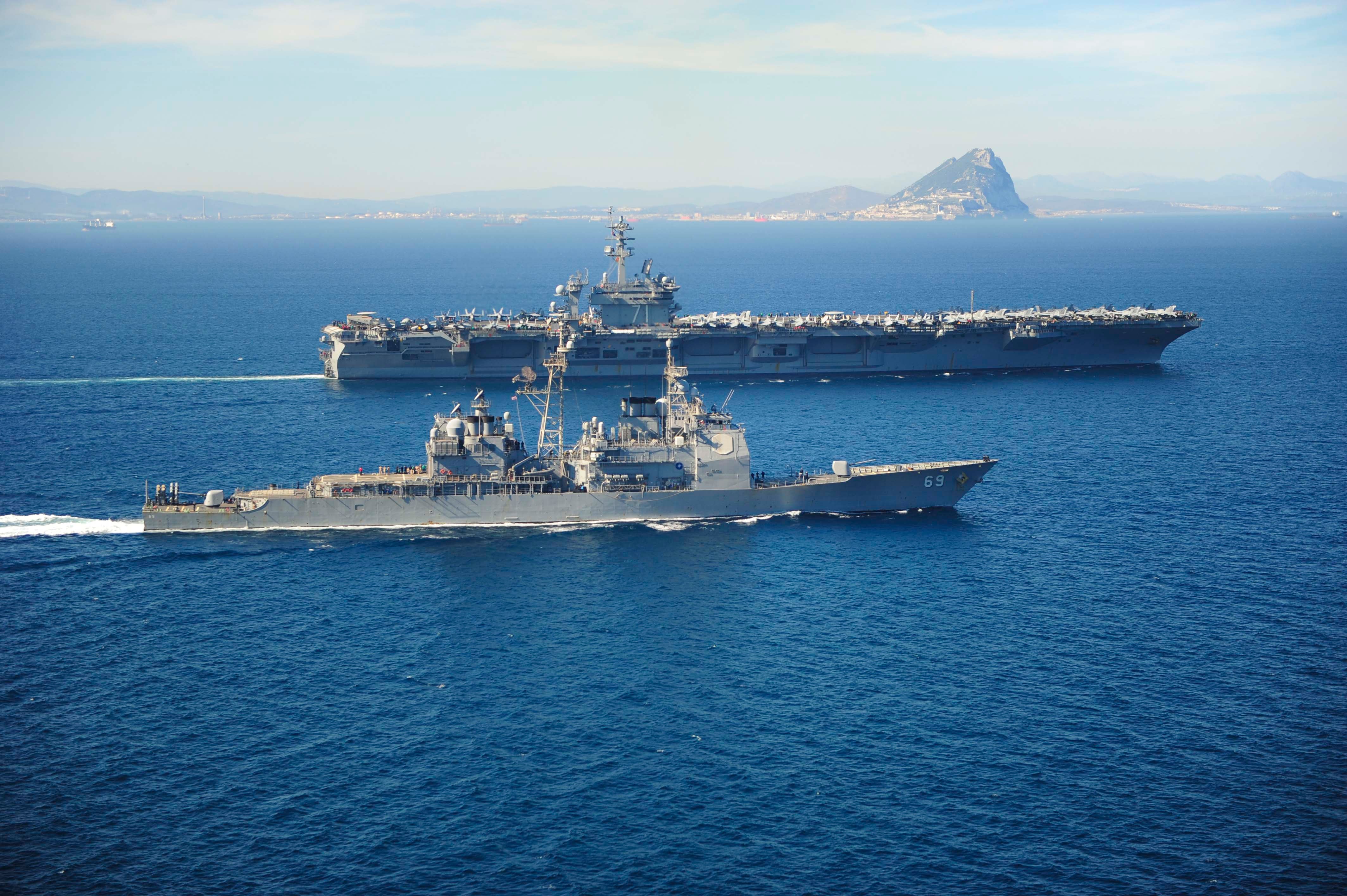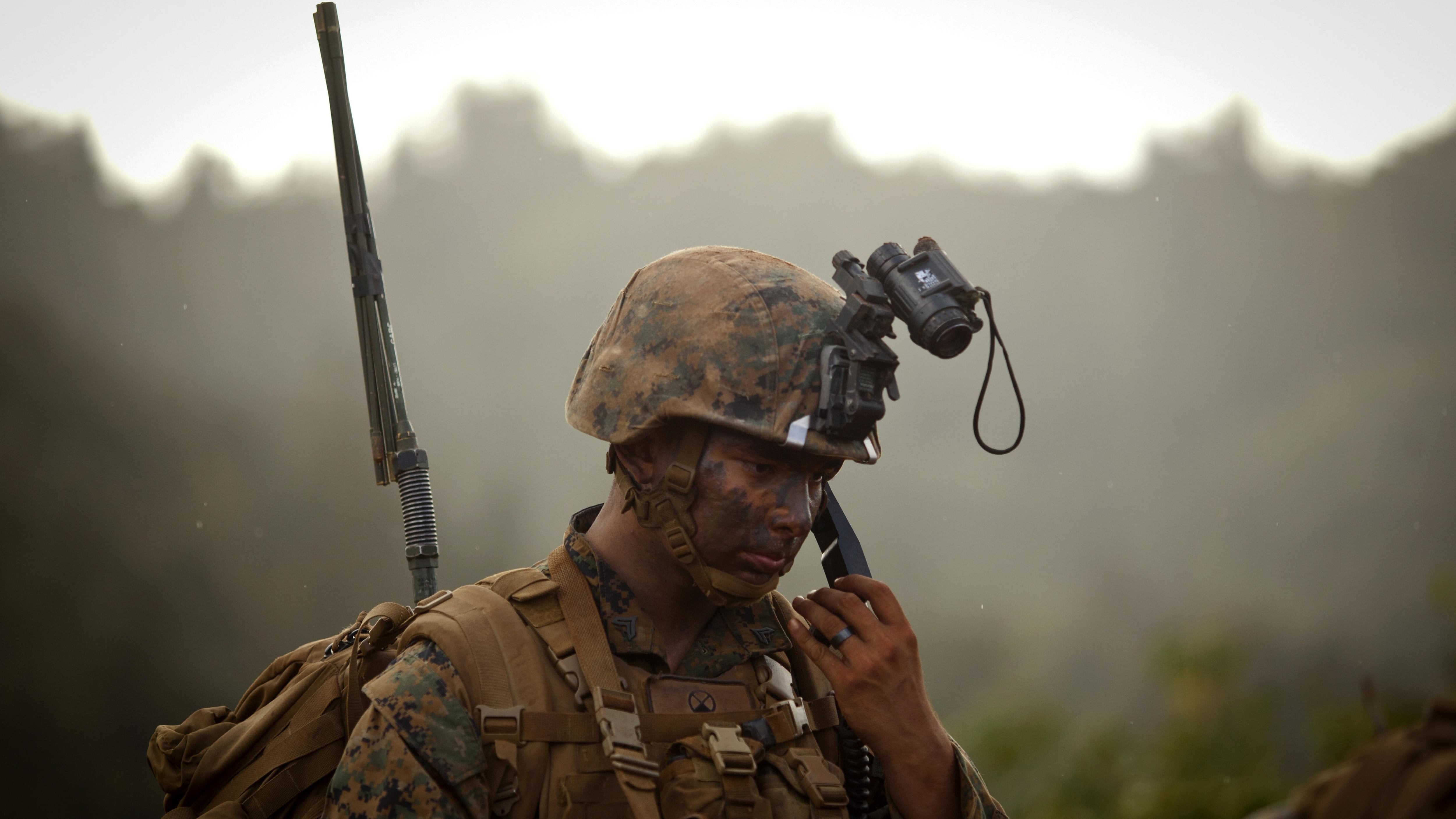President-elect Donald Trump wants a much bigger military. All he needs to do is find the money and political support to make it happen.
Less than two weeks into the Republican businessman's transition from unlikely presidential candidate to unlikely commander in chief, many details of his plans for the Defense Department remain unsettled. His picks to lead the Pentagon, the individual services and his national security staff are still unsettled. Retired Army Lt. Gen. Mike Flynn was named his administration's national security adviser on Friday, and Trump has been reaching out to potential defense secretary candidates in recent days, including retired Marine Corps Gen. James Mattis, who as the head of U.S. Central Command from 2010 to 2013 choreographed the wars in Afghanistan and Iraq under President Obama.
General James "Mad Dog" Mattis, who is being considered for Secretary of Defense, was very impressive yesterday. A true General's General!
— Donald J. Trump (@realDonaldTrump) November 20, 2016
The common thread between Team Trump's transition discussions and the president-elect's campaign rhetoric is a belief that defense spending has dropped to dangerously low levels, and that the military needs to add lots of people — more than 160,000 by some estimates — along with investing heavily in new ships and aircraft.
Trump wants an active-duty Army with another 60,000 soldiers in the ranks, an unspecified number of additional sailors to man the 78 ships and submarines he intends to see built in coming years. He wants up to 12,000 more Marines to serve in infantry and tank battalions, and at least another 100 combat aircraft for the Air Force.
If Trump's administration can accomplish even a portion of this, it could have sweeping effects on rank-and-file military personnel, touching everything from individual advancement opportunities to the number of U.S. troops stationed overseas and overall operational tempo. The scope of growth being suggested would require many more officers and noncommissioned officers, influencing, over the course of several years, how each service recruits, promotes and retains its workforce.
It could reshape how many American troops find themselves assigned to geopolitical hot spots, including the Middle East, Eastern Europe and Southeast Asia. And all of this, in theory, would ease the pace at which service members are deployed or actively preparing to go overseas, which amounts to time away from their homes and families.
It is unclear, though, whether Trump's plans include a boost for troops' pay and benefits, the value of which has eroded as annual raises have fallen below civilian wage growth for the past five years. This has become a source of frustration and anxiety among rank-and-file personnel, many of whom feel they've been asked to do more with less.
In the past, cuts to military personnel accounts came at the request of the Pentagon's top brass, which voiced concerns that rising personnel costs would take money from modernization and readiness accounts. And any plans to ratchet up the size of the force could renew pressure on military personnel accounts because maintaining a larger force costs more money.
Standing in Trump's way is the ongoing fight in Washington over mandatory spending caps enacted by Congress in 2011 with hopes of reigning in the federal budget. This has inflicted a unique form of paralysis on the Pentagon, in particular, which has managed to ease some shortfalls by leveraging the $25 billion to $30 billion set aside each year for combat operations and other overseas contingencies.
Although there is widespread distaste for the Budget Control Act, lawmakers have been unable to negotiate a way forward that increases defense spending while ensuring other areas of the budget are kept in check. Republican leaders in Congress say they are hopeful the next administration, coupled with a Republican majority in both houses, will bring new possibilities for a repeal. But Democrats have promised a fight if Trump and his administration insist on increasing defense spending without boosting domestic programs.
"Both presidential candidates called for an end to sequestration for defense," said Rep. Michael Turner, R-Ohio and a key member of the House Armed Services Committee. "I believe Congress is ready to repeal it, certainly on the military side."
Yet even if a compromise is reached on Capitol Hill, the cost for Trump’s military proposals may be too much for fiscal hawks to accept. Earlier this month, officials from the conservative American Enterprise Institute estimated "about $55 to $60 billion extra per year over four years for the meat and potatoes of a military buildup." Fully implementing his plan would surely push that number higher.
"Adding in crucial smaller programs, accounting for weapons cost growth, and returning the entire force to adequate readiness pushes the real price tag even further upward," the report said. A more realistic figure is "somewhere between an additional $250 to $300 billion over four years."
Convincing Democrats and skeptical Republicans already wary of federal debt to support such massive investments will take political savvy and legwork, much of which will fall on Trump’s yet-to-be-named military appointees.
AN ARMY OF 540,000
Trump's military agenda has been heavily influenced by researchers at the conservative Heritage Foundation, a Washington think tank. Its annual " Index of U.S. Military Strength," released in mid-November, concludes that America's armed forces have withered. They are, the report argues, "only marginally able to meet the demands of defending vital national interests." It assigns that term — "marginal" — to the Navy, Air Force and Marine Corps.
The Army is in much worse shape, according to these findings. With only one-third of the force at "acceptable" readiness, the Army has become "smaller, older and weaker," the Heritage report warns.

If current downsizing plans remain intact, the Army and Marine Corps will drop to their smallest combined size in almost 70 years.
Photo Credit: Staff Sgt. Jennifer Bunn/Army
Trump has said he wants to halt the Army's planned personnel drawdown, which is on course to bottom out at 450,000 active-duty soldiers in 2018. Instead, he wants boost today's force by 60,000, for a total of 540,000 soldiers. Defense advocates, even those who've been critical of Trump, say this is a necessity.
"The Army is grossly undermanned." said retired Gen. Barry McCaffrey, a 32-year infantry officer who held top-level posts at the Pentagon and in NATO and later served as drug czar in President Bill Clinton's administration. "You’ve got to have a military combat capability that is believed by the Russians and the North Koreans, among others, as being capable and willing to confront them in an air-ground-sea battle."
McCaffrey said specifically that there is "inadequate ground combat power" in Europe, which is under threat from a resurgent Russia. Trump has indicated he wants to reset relations with Moscow, but Pentagon leadership and even members of his own party believe that would be a mistake. The Heritage Foundation says Russia is the primary threat to American interests, followed by Iran, China and terrorist groups such as the Islamic State. North Korea was downgraded, from "hostile" to merely "aggressive."
It is unclear whether the growth Trump envisions would translate to more troops deployed or assigned outside the United States. He has said he wants foreign allies to take a larger role providing for their own defense, hinting that some overseas military bases could be consolidated or shuttered. But McCaffrey said he is confident Trump will see value in those alliances and strive to reinforce U.S. military presence in key regions.
"At some point," the retired general said, "math counts in warfare. If you don’t want to fight, then maintain a capability that is persuasive to your adversary as being capable of taking them on."
DOZENS OF NEW SHIPS & SUBMARINES
Trump also as vowed to build the 350-ship Navy that Republican defense hawks have long sought. Today, the battle force totals 272 ships and submarines.
It's unclear what mix of ships the incoming administration wants to build, but one thing is for sure: There will be considerable cost. Ford-class aircraft carriers, for instance, are about $10 billion each. A single Virginia-class attack sub is $3 billion. Each new littoral combat ship is $500 million. And beyond hardware, this plan would require the addition of 50,000 sailors, by one estimate.
In a campaign memo, Trump advisers promised specifically to fund modernizing "a significant number of the Navy's Ticonderoga-class cruisers," some of which have been sidelined for months or years pending overhauls. The memo describes plans to invest heavily in new subs and Arleigh Burke-class destroyers, and to revitalize shipyards and get warships the maintenance that has been deferred in the last few years because due to budget cuts. Trump wants to identify where old shipyards went out of business and have the ability to restart, an effort that would be led by the incoming Navy secretary, and to build a robust training pipeline for skilled workers in the shipyards. This would increase the support base for a growing Navy.

The Ticonderoga-class cruiser Vicksburg escorts the Nimitz-class aircraft carrier Theodore Roosevelt as they pass the Rock of Gibraltar while entering the Mediterranean Sea.
Photo Credit: MCSN Anthony Hopkins/Navy
Even if Trump's administration can find the money needed for such a dramatic expansion, new ships can't be built overnight. Reaching a fleet of the size Trump has proposed will take until the 2030s, said Bryan Clark, who served as senior aide to Chief of Naval Operations Adm. Jon Greenert and now works as an analyst with the Center for Strategic and Budgetary Assessments. To get there, the Navy would need to accelerate aircraft carrier production, start building three Virginia-class attack submarines per year, continue to commission new Littoral Combat Ships and have new frigates doing low-end missions in 2019.
Such a buildup would propel the service from a force of 330,000 sailors today to more than 380,000. If enacted, Trump's Navy would be largest size since 1998.
MORE AIRCRAFT & AIRMEN TO MAINTAIN THEM
Trump's Air Force would boast 1,200 fighter aircraft, ideally, an increase of about 100. Including surveillance, cargo planes and other platforms, the Air Force fleet numbers nearly 2,000 today.
Defense advocates are hopeful that Trump's administration will push to supplement the Air Force’s operations and maintenance budget, making it easier to pay for spare parts, fuel and training hours. "It needs to be done," said retired Gen. Merrill McPeak, who was the Air Force’s chief of staff during the first Gulf War. "The Air Force is too small now, and in particular, the combat flying elements of the Air Force are too small. If he is able to follow through on such a notion, I think that would be grand."

The Air Force needs to refocus on improving readiness and training, says former Chief of Staff Gen. Merrill McPeak. More money would enable more flying hours in general and more large-scale exercises, and help it remain sharp if the U.S. pulls back from the Middle East.
Photo Credit: Air Force photo
The Air Force has declined from its post-9/11 peak of 376,616 airmen in fiscal 2004 to roughly 311,000 in fiscal 2015. That drawdown was most painfully felt in 2014, when a series of voluntary and involuntary force management programs cut roughly 20,000 airmen in two years and left the active-duty Air Force at its lowest end strength since 1948 — the year after it was established as its own service.
Air Force Secretary Deborah Lee James later admitted that she soon realized the sequestration-driven force cuts "just didn't seem to be adding up anymore," and were causing significant strain on the force. So leaders refocused on trying to rebuild, especially in crucial areas such as cyber security, intelligence, surveillance and reconnaissance, battlefield airmen and maintenance. Today, the Air Force numbers about 317,000.
John Venable, an Air Force veteran and a defense fellow at the Heritage Foundation, said he believes Trump could boost Air Force personnel by roughly 40,000 airmen in the next few years, a number needed to operate and maintain the new equipment Trump wants to buy. But it will have to be a methodical growth to bring airmen on board and train them, he said. Today, the Air Force is about 700 pilots short, and training new personnel to replace departing pilots is not a quick process.
ENOUGH MARINES TO FIGHT TWO WARS AT ONCE
Trump has promised to build a Marine Corps capable of simultaneously
winning
two wars. It would be based on 36 battalions, up from the current force structure of 24 active-duty infantry battalions, two active-duty tank battalions and supporting units. That means adding between 8,000 and 12,000 more Marines to the service’s roster, another potentially expensive personnel plus-up dependent on a significant influx of new funding. Using the fiscal 2017 personnel costs as a base, that could total more than $1 billion per year just in personnel costs, before equipment and training are factored in.
But supporters say it’s worth the cost. "A Marine Corps of 36 battalions would enable an ability to handle a major conflict and an ability to handle other taskings around the world, wherever this may be," Dakota Wood, a retired Marine lieutenant colonel and senior fellow at the Heritage Foundation.

About 17 percent of the service's active-duty force is now deployed. More personnel would give Marines more time between deployments.
Photo Credit: Cpl. Aaron Patterson/Marine Corps
By getting larger, the service would also be able to give Marines more time at home between deployments, he said. Currently, 31,277 Marines are forward deployed, about 17 percent of the service's active-duty force, officials said. Traditionally, the Marine Corps has committed 15 battalions to conflicts such as Vietnam and the Gulf War, Wood added. Having 30 battalions plus an extra six for units that are training or otherwise unavailable to deploy would allow the Marines to be more than a one-war force.
"We say that the United States needs to have the ability to handle two wars," Wood said. "Not that we’re saying that we’re going to be in two wars simultaneously, but if you only have a one-war force and you have to commit to it, that’s everything."
With reporting by Stephen Losey of Air Force Times, David Larter of Navy Times, Meghann Myers of Army Times and Jeff Schogol of Marine Corps Times.
Leo Shane III covers Congress, Veterans Affairs and the White House for Military Times. He can be reached at lshane@militarytimes.com.
Andrew Tilghman is Military Times' Pentagon bureau chief. He can be reached at atilghman@militarytimes.com.
Andrew Tilghman is the executive editor for Military Times. He is a former Military Times Pentagon reporter and served as a Middle East correspondent for the Stars and Stripes. Before covering the military, he worked as a reporter for the Houston Chronicle in Texas, the Albany Times Union in New York and The Associated Press in Milwaukee.
Leo covers Congress, Veterans Affairs and the White House for Military Times. He has covered Washington, D.C. since 2004, focusing on military personnel and veterans policies. His work has earned numerous honors, including a 2009 Polk award, a 2010 National Headliner Award, the IAVA Leadership in Journalism award and the VFW News Media award.




